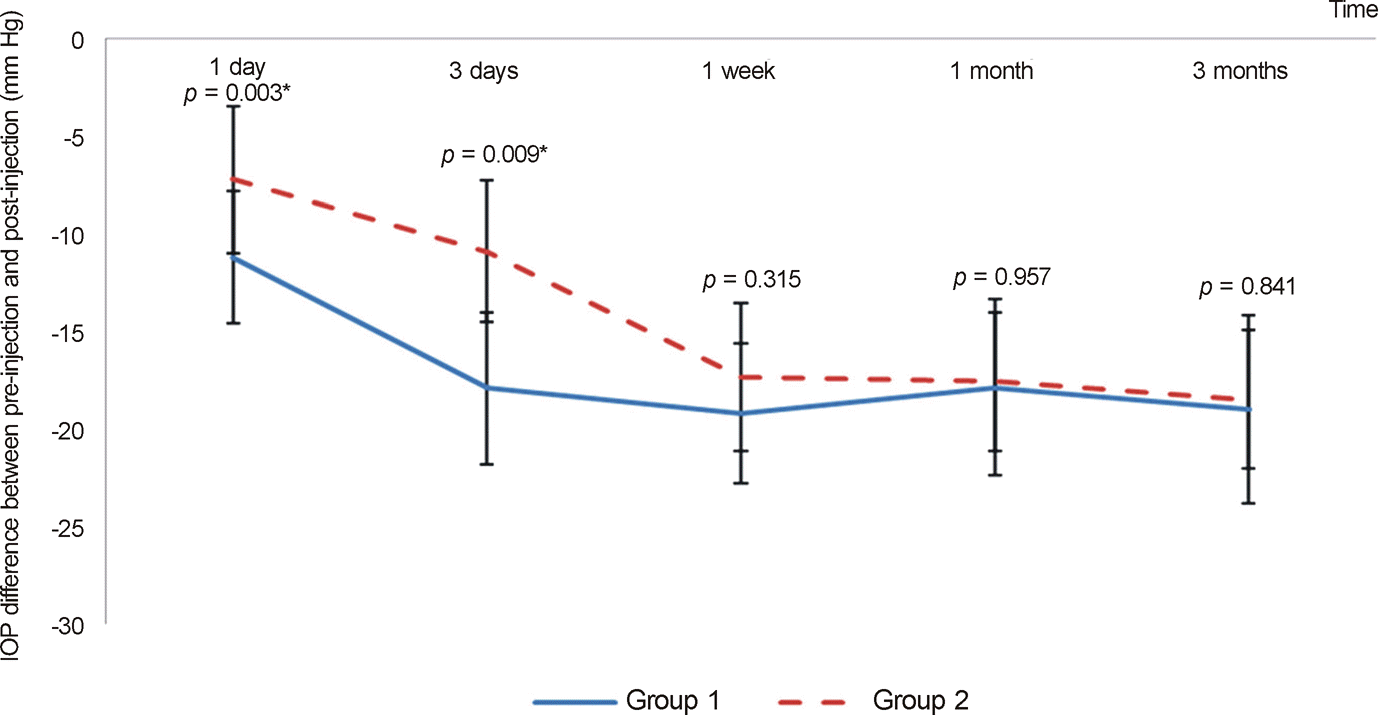1. Sivak-Callcott JA, O'Day DM, Gass JD, Tsai JC. Evidence-based recommendations for the diagnosis and treatment of neovascular glaucoma. Ophthalmology. 2001; 108:1767–76.
2. Shazly TA, Latina MA. Neovascular glaucoma: etiology, diagnosis and prognosis. Semin Ophthalmol. 2009; 24:113–21.

3. Aiello LP. Vascular endothelial growth factor and the eye: biochemical mechanisms of action and implications for novel therapies. Ophthal Res. 1997; 29:354–62.

4. Aiello LP, Avery RL, Arrigg PG, et al. Vascular endothelial growth factor in ocular fluid of patients with diabetic retinopathy and other retinal disorders. N Engl J Med. 1994; 331:1480–7.

5. Tripathi RC, Li J, Tripathi BJ, et al. Increased level of vascular endothelial growth factor in aqueous humor of patients with neovascular glaucoma. Ophthalmology. 1998; 105:232–7.

6. SooHoo JR, Seibold LK, Kahook MY. Recent advances in the management of neovascular glaucoma. Semin Ophthalmol. 2013; 28:165–72.

7. Michels S, Rosenfeld PJ, Puliafito CA, et al. Systemic bevacizumab (Avastin) therapy for neovascular age-related macular degeneration twelve-week results of an uncontrolled open-label clinical study. Ophthalmology. 2005; 112:1035–47.
8. Spaide RF, Laud K, Fine HF, et al. Intravitreal bevacizumab treatment of choroidal neovascularization secondary to age-related macular degeneration. Retina. 2006; 26:383–90.

9. Rosenfeld PJ, Fung AE, Puliafito CA. Optical coherence tomography findings after an intravitreal injection of bevacizumab (avastin) for macular edema from central retinal vein occlusion. Ophthalmic Surg Lasers Imaging. 2005; 36:336–9.

10. Iturralde D, Spaide RF, Meyerle CB. Intravitreal bevacizumab (Avastin) treatment of macular edema in central retinal vein occlusion: a short-term study. Retina. 2006; 26:279–84.
11. Spaide RF, Fisher YL. Intravitreal bevacizumab (Avastin) treatment of proliferative diabetic retinopathy complicated by vitreous hemorrhage. Retina. 2006; 26:275–8.

12. Davidorf FH, Mouser JG, Derick RJ. Rapid improvement of rubeosis iridis from a single bevacizumab (Avastin) injection. Retina. 2006; 26:354–6.

13. Silva Paula J, Jorge R, Alves Costa R, et al. Short-term results of intravitreal bevacizumab (Avastin) on anterior segment neovascularization in neovascular glaucoma. Acta Ophthalmol Scand. 2006; 84:556–7.

14. Grisanti S, Biester S, Peters S, et al. Intracameral bevacizumab for iris rubeosis. Am J Ophthalmol. 2006; 142:158–60.

15. Mason JO 3rd, Albert MA Jr, Mays A, Vail R. Regression of neovascular iris vessels by intravitreal injection of bevacizumab. Retina. 2006; 26:839–41.

16. Ilieve ME, Domig D, Wolf-Schnurrbursch U, et al. Intravitreal bevacizumab (Avastin) in the treatment of neovascular glaucoma. Am J Ophthalmol. 2006; 142:1054–6.
17. Andrijevic’-Derk B, Vatavuk Z, Bencic’ G, et al. Intravitreal bevacizumab for neovascular glaucoma. Acta Clin Croat. 2008; 47:175–9.
18. Martinez-Carpio PA, Bonafonte-Marquez E, Heredia-Garcia CD, Bonafonte-Royo S. Efficacy and safety of intravitreal injection of bevacizumab in the treatment of neovascular glaucoma: systematic review. Arch Soc Esp Oftalmol. 2008; 83:579–88.

19. L'Esperance FA. Ophthalmic lasers. 3rd ed.1. St Louis: CV Mosby Co.;1989. p. 78–112.
20. Saito Y, Higashide T, Takeda H, et al. Clinical factors related to recurrence of anterior segment neovascularization after treatment including intravitreal bevacizumab. Am J Ophthalmol. 2010; 149:964–72.

21. Brouzas D, Charakidas A, Moschos M, et al. Bevacizumab (Avastin) for the management of anterior chamber neovascularization and neovascular glaucoma. Clin Ophthalmol. 2009; 3:685–8.
22. Diabetic Retinopathy Study. Photocoagulation treatment of proliferative diabetic retinopathy: the second report of diabetic retinopathy study findings. Ophthalmology. 1978; 85:82–106.
23. Manaviat MR, Rashidi M, Afkhami-Ardekani M, et al. Effect of pan retinal photocoagulation on the serum levels of vascular endothelial growth factor in diabetic patients. Int Ophthalmol. 2011; 31:271–5.

24. Wolf A, von Jagow B, Ulbig M, Haritoglou C. Intracameral Injection of bevacizumab for the treatment of neovascular glaucoma. Ophthalmologica. 2011; 226:51–6.

25. Yuzbasioglu E, Artunay O, Rasier R, et al. Simultaneous intravitreal and intracameral injection of bevacizumab (Avastin) in neovascular glaucoma. J Ocul Pharmacol Ther. 2009; 25:259–64.

26. Ghanem AA, El-Kannishy AM, El-Wehidy AS, El-Agamy AF. Intravitreal bevacizumab (avastin) as an adjuvant treatment in cases of neovascular glaucoma. Middle East Afr J Ophthalmol. 2009; 16:75–9.

27. Bakri SJ, Snyder MR, Reid JM, et al. Pharmacokinetics of intra- vitreal bevacizumab (Avastin). Ophthalmology. 2007; 114:855–9.
28. Matsuyama K, Oqata N, Jo N, et al. Levels of vascular endothelial growth factor and pigment epithelium-derived factor in eyes before and after intravitreal injection of bevacizumab. Jpn J Ophthalmol. 2009; 53:243–8.

29. Sheng YH. Vitreous prolapse during cataract surgery. Zhonghua Yan Ke Za Zhi. 1993; 29:27–9.
30. Larsson L, Osterlin S. Retinal vessels in the ora region. Possible role in the vitreo-retinal pathology in aphakia. Acta Ophthalmology. 1981; 59:526–31.
31. Sato T, Morita S, Bando H, et al. Early vitreous hemorrhage after vitrectomy with preoperative intravitreal bevacizumab for pro- liferative diabetic retinopathy. Middle East Afr J Ophthalmol. 2013; 20:51–5.
32. Kuiper EJ, Van Nieuwenhoven FA, de Smet MD, et al. The angio-fibrotic switch of VEGF and CTGF in proliferative diabetic retinopathy. PLoS One. 2008; 3:e2675.

33. Widder RA, Lemmen KD, Dietlein TS. Neovascular glaucoma. Klin Monbl Augenheikd. 2010; 227:R15–27.
34. Ehlers JP, Spirn MJ, Lam A, et al. Combination intravitreal bevacizumab/panretinal photocoagulation versus panretinal photo- coagulation alone in the treatment of neovascular glaucoma. Retina. 2008; 28:696–702.
35. Rusovici R, Sakhalkar M, Chalam KV. Evaluation of cytotoxicity of bevacizumab on VEGF-enriched corneal endothelial cells. Mol Vis. 2011; 17:3339–46.
36. Chalam KV, Agarwal S, Brar VS, et al. Evaluation of cytotoxic effects of bevacizumab on human corneal cells. Cornea. 2009; 28:328–33.
37. Suh SY, Lee JH, Jun RM. Corneal endothelial change after intravitreal bevacizumab injection. J Korean Ophthalmol Soc. 2010; 51:1549–53.






 PDF
PDF ePub
ePub Citation
Citation Print
Print


 XML Download
XML Download